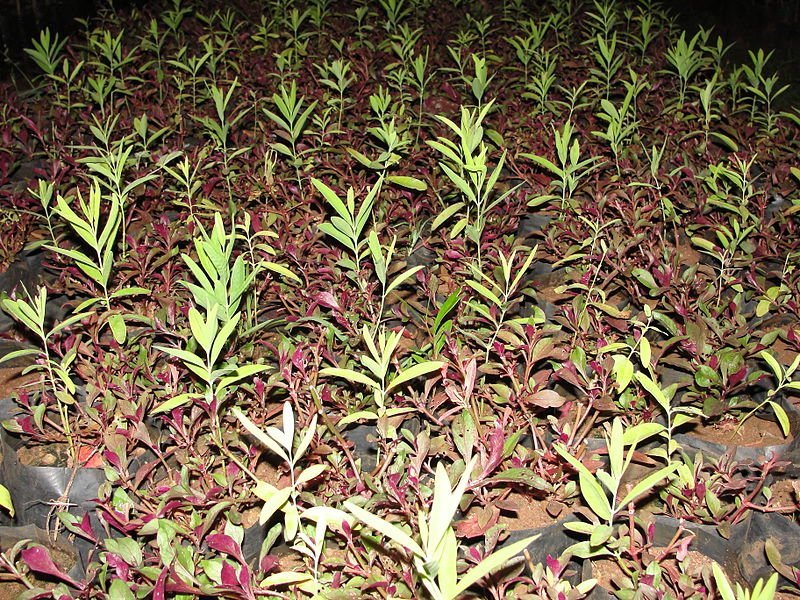Sandalwood essential oil is an effective essential oil for treating headaches, muscle pains, and joint pains. Its aroma also has a relaxing and calming effect on the mind and body, helping us overcome stress, fatigue, and anxiety. This oil is produced from the roots of the sandalwood tree. High-grade sandalwood essential oil comes from the Santalum album tree, which is native to India. Its wood and roots are used to make powders, incense, cosmetics, teas, and essential oils. In the local culture of India, the Santalum album is much desired and respected. In fact, some even consider this tree to be holy.
If you’ve noticed, sandalwood essential oils cost higher compared to other kinds of essential oils. Well, one of the reasons is because of the huge international demand for the Santalum album tree. The tree takes a long time to grow, and before it is harvested, it must mature for forty to eighty for the best results. Aside from that, sandalwood trees, as mentioned earlier, are used in many other purposes and not just in making essential oil. Let us know more about the reasons of sandalwood’s high cost.
The Global Sandalwood Boom
Sandalwood has become a thriving market because of the rising demand combined with a supply shortage. Due to this, the price of sandalwood has been increasing by 20% to 25% annually, which results in a liter of sandalwood oil retailing five times higher than a comparable amount of silver.
Sandalwood products are used globally, but Asia is the most significant growth market where China alone accounts for half of the expected global demand growth. There is sufficient demand for sandalwood due to its importance in traditional medicine, woodworking, pharmaceuticals, perfumes, and as well as Hindu and Buddhist rituals. These demands allow the companies operating in this sector to reap significant profits.
Decreased Production of Sandalwood
There’s a strong demand for sandalwood. However, its production has decreased. Due to its high value and rising demand in both internal and external markets, prices of sandalwood have skyrocketed. From 1900 to 1990, the price range of sandalwood increased from 365 Rs per ton to 7800 Rs per ton. It’s like rising from $5 to $100 per ton.
From the 1930s to the 1950s, India was able to produce roughly 4,000 tons of heartwood every year. But recently, only 2,000 tons are being produced each year. It was in the 1970s when the demand for sandalwood oil fell abruptly as an outcome of very high prices and rivalry from synthetic alternatives.
The Complex Farming Method of Sandalwood
Aside from the high demand and low supply of sandalwood, another factor for its high cost is its complicated farming method. Sandalwood is cultivated widely in India and Australia. In India, natural sandalwood trees are found in Andhra Pradesh, Tamil Nadu, Kerala, and Karnataka. These trees can take decades to grow and reach maturity.
When planting sandalwood trees, the soil should have a pH value between 6.5 and 7.5. Also, 7 to 8 months old saplings that have grown one foot are only allowed to be planted for cultivation. But before they are planted, holes that have 1.5 feet length, width, and depth are first filled with cow dung powder and soil.
Sandalwood trees only need moderate irrigation. If you overwater them, they might perish. Also, their roots need the presence of other plants at about 1.5 to 2 meters so that they can easily absorb nutrients from the soil. It’s because the roots of sandalwood trees absorb nutrients partially from the roots of other plants. Some of the great plants for this are pigeon peas, papaya, and a quick-stick. Weeds like mimosa can also help the growth of sandalwood trees. However, only a limited number of those weeds should be allowed.
After 7 to 8 years, the sandalwood tree will begin growing one kilogram per year. When it turns 15 years old, its bark will be formed. When it becomes fully grown, it will have a length of 13 to 16 meters and a diameter of 1 to 2 meters. Remember, when planting and growing sandalwood trees, no chemical pesticides or fertilizers are used. They are also normally uprooted and not chopped off because their roots also make a high price according to their weight.
Sandalwood Trees Are Protected by Law
Another reason for sandalwood’s high cost is because of the effort it takes to harvest it. In Kerala, sandalwood trees grow in natural habitat at Marayur in the Idukki district. There are more than 200 forest guards appointed to protect the trees due to many cases of sandalwood smuggling. It’s because sandalwood trees are protected by law. It means that before a sandalwood tree is cut or uprooted, prior permission is needed from the government. Therefore, even if you have a sandalwood tree in your backyard, government permission is still required if you want to cut it.
Also, know that sandalwood is now a near-extinct species in the wild due to the amount of sandal oil, paste, and wood that people use. The trees are being harshly chopped for this, and the demand for sandal has far surpassed the availability of sandalwood trees in the forests. In fact, Australia is currently producing more sandalwood compared to India through its commercial sandalwood plantations in Western Australia.
These are the reasons why sandalwood essential oils cost so much higher compared to other essential oils out there. Sandalwood is indeed a precious tree, and we hope it can be saved from extinction so that it can continue providing wonderful benefits to people. Maybe we can also help by not taking sandalwood oil, paste, and wood for granted.



